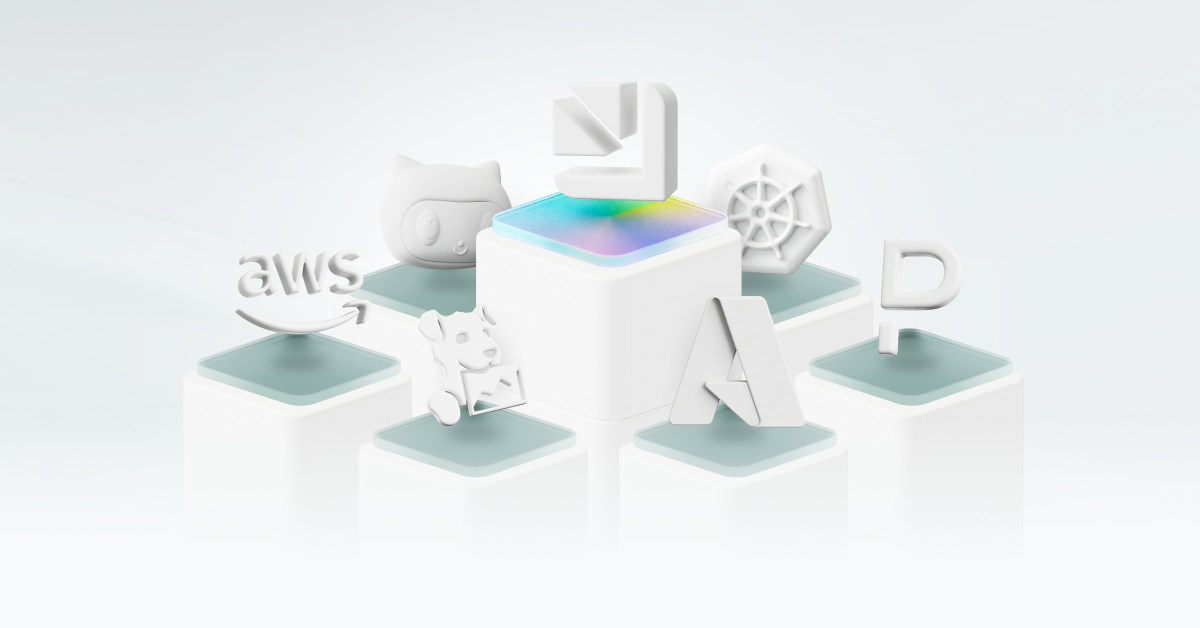
Every platform engineering journey starts the same way — with integrations.
Before you can deliver self-service actions, enforce standards, or show value to leadership, your internal developer portal needs to know what it’s orchestrating. Without integrating your tech stack, there’s no data in the portal, no automations to build, and no visibility into your software catalog relationships. You can’t measure reliability, track deployments, or surface incidents.
Integrations aren’t just the first step of portal setup — they are the portal setup. They connect your tools, data, and workflows into a single layer of control, giving platform engineers everything they need to design, automate, and operate developer experiences that scale.
For platform engineers onboarding into Port, integrations are your “Day 0” activity. They define how your platform will function, how your developers will work, and how your organization will measure engineering health. The sooner you connect your stack, the faster you deliver value — and the stronger your foundation for AI-assisted and agentic engineering becomes.
How integrations unlock Port’s value for platform teams
Integrations are the connective tissue of your internal developer portal. Every feature in Port — from software catalogs to scorecards to self-service automations — depends on the data you store inside them.
- No integrations, no portal. Port is an orchestration layer, not a standalone product. Without connecting systems like GitHub, Jira, Kubernetes, Datadog, or Terraform, there’s nothing for Port to visualize or automate.
- The catalog depends on integrations. Your software catalog is populated from your existing stack. Services, APIs, resources, and dependencies appear automatically once your tools are connected — otherwise, the catalog is empty.
- Self-service is powered by integrations. Every workflow — spinning up a sandbox, provisioning infrastructure, scaffolding a new service — depends on connected systems. No integrations means no self-service.
- Scorecards and standards rely on integrations. Compliance checks, documentation benchmarks, and test-coverage metrics only work if Port can pull real data from your systems of record.
- Observability and insights flow through integrations. Port surfaces DORA metrics, incidents, and cost data from connected observability tools, giving platform teams real-time visibility into reliability and performance.
- Integrations = immediate ROI. As soon as your systems are connected, you start seeing automation, governance, and insight — turning your internal developer portal from an idea into an operating platform.
Integrations aren’t a background task. They’re the mechanism through which your portal — and your platform team — delivers value to every engineer in the organization.

Why integrations need to be structured by platform engineers
It’s not enough to just connect your tools and tech stack. Platform engineers need to structure integrations intentionally to help other teams make sense of their relationships and dependencies.
Without that structure, teams risk recreating the very complexity they’re trying to solve — scattered knowledge, unclear ownership, and disconnected workflows.
Structuring your integrations helps support the following:
- Reducing institutional knowledge risk. When your integrations are thoroughly mapped in Port, they become a platform. Their dependencies, ownership, and relationships become visible to everyone. No more “institutional knowledge” locked in a single engineer’s head, and no more confusion around how services and entities interact.
- Mapping relationships and dependencies. By connecting systems like GitHub, Kubernetes, and your CI/CD pipelines, you reveal how your stack actually works, which helps you create a functional software development lifecycle and a single source of truth for infrastructure and ownership.
- Reducing context switching. Integrations consolidate dozens of dashboards and tools into one unified portal, giving engineers a single pane of glass for their work.
- Accelerating onboarding for new platform engineers. With integrations documented and visible, new hires can explore the platform ecosystem without guesswork or manual setup.
- Enabling proactive automation. Once integrations are mapped, recurring tasks like environment cleanup, policy enforcement, and cost management can be automated with confidence.
At Aptos Retail, for example, the platform team structured its integrations early in their onboarding process with Port, and discovered an orphaned S3 bucket that cost them $30K per year. The fix helped pay for the project before the portal even went live.
For every platform engineer, structured integrations are both the starting point and the roadmap for building scalable, maintainable internal platforms.
How integrations transform the onboarding journey
Onboarding metrics like time to 10th PR are specifically designed to help engineers understand how easily and efficiently new hires become acclimated to their new environments. Structuring integrations along a standard lifecycle ensures your platform scales smoothly from design to operation, and devs learn their environments quickly.
Onboarding doesn’t start when a developer or platform engineer joins — it starts when you design your platform. The best teams align their onboarding flows with the same lifecycle they use to operate production systems: Day 0, Day 1, and Day 2.
Day 0: Design & define
Before anyone logs in, you have to install your integrations. Integrations help platform teams define the blueprints and schemas that underpin the software catalog. Connecting systems like GitHub, Jira, and Kubernetes up front allows you to automatically ingest repositories, environments, and pipelines. From there, you can set standards for naming conventions, roles, and metadata.
Day 0 integrations turn chaos into clarity — your catalog, scorecards, and automations are defined before the first service is ever created.
Day 1: Setup & access
On Day 1, new platform engineers immediately benefit from the structure of foundational integrations. They can see every system, service, and dependency as soon as they log in because the stack is already mapped. Self-service actions, like scaffolding a new service, deploying an environment, or assigning RBAC roles just work. No tickets, no waiting, no guesswork — developers benefit from domain-integrated context and control from the first day on the job.
Day 2: Operate & maintain
Integrations continue to add value as the platform matures. With monitoring, alerting, and observability tools connected, platform engineers can track usage, detect incidents, and improve reliability from within Port. Integrated dashboards show which services comply with standards, which teams need help, and where automations or AI agents can eliminate manual work. Continuous feedback loops powered by integrations keep your platform evolving with the organization.
Ocean: Scaling integrations without the overhead
Every company’s tech stack is different — and that’s why Ocean exists.
Ocean is Port’s open-source integration framework that makes it easy to connect any system, whether it’s a popular DevOps tool or a home-grown internal service. With its plug-and-play architecture, platform teams can start fast with prebuilt integrations for GitHub, Jira, Kubernetes, and Datadog, or build their own when they need deeper connections.
For organizations with unique infrastructure, Ocean ensures there are no blockers to full visibility. You can sync metadata, ownership, and dependencies automatically — populating your catalog and powering your workflows with live data from across your ecosystem.
Ocean gives platform engineers flexibility and control: integrate what exists, extend what’s missing, and keep your portal aligned with the reality of your stack. When every system contributes data, every onboarding — for developers or platform engineers — starts fully connected.
For more technical detail, see Build your custom integration in Port’s documentation.
The ROI of integration-first portal building
Integration-first onboarding pays off immediately — not just in developer velocity, but in platform team productivity and organizational efficiency.
- For platform engineers: Integrations automate manual setup, reduce ticket load, and provide a unified data model for every workflow.
- For developers: Integrated portals unlock true self-service — faster provisioning, easier debugging, and fewer bottlenecks.
- For engineering leaders: Integrated visibility drives measurable improvements in productivity, reliability, and cost control.
Across Port customers, the results speak for themselves:
- A telecommunications provider cut onboarding time in half with a centralized portal.
- A financial services firm improved onboarding and collaboration through a connected API catalog.
- A leading health insurance provider in Australia reduced service scaffolding time from 15 days to 25 minutes.
- A UK financial services provider cut infrastructure provisioning from months to 90 minutes.
Every one of these outcomes began the same way — with platform engineers integrating their existing tools into Port.
When integrations come first, the portal delivers value immediately: onboarding accelerates, institutional knowledge becomes accessible, and every team gains confidence in the systems they build and operate.
Conclusion
For platform engineers, integrations aren’t just part of onboarding — they are onboarding. They define how your platform operates, how your teams collaborate, and how your developers experience your systems.
Start by connecting your stack. Map your GitHub repos, sync your Jira projects, tie in your Kubernetes clusters, and Datadog metrics. From there, automation, visibility, and governance follow naturally.
Integrations are the foundation of a modern platform, and with Port, that foundation is easier than ever to build.
{{cta_3}}
Get your survey template today
Download your survey template today
Free Roadmap planner for Platform Engineering teams
Set Clear Goals for Your Portal
Define Features and Milestones
Stay Aligned and Keep Moving Forward
Create your Roadmap
Free RFP template for Internal Developer Portal
Creating an RFP for an internal developer portal doesn’t have to be complex. Our template gives you a streamlined path to start strong and ensure you’re covering all the key details.
Get the RFP template
Leverage AI to generate optimized JQ commands
test them in real-time, and refine your approach instantly. This powerful tool lets you experiment, troubleshoot, and fine-tune your queries—taking your development workflow to the next level.
Explore now
Check out Port's pre-populated demo and see what it's all about.
No email required
.png)
Check out the 2025 State of Internal Developer Portals report
No email required
Minimize engineering chaos. Port serves as one central platform for all your needs.
Act on every part of your SDLC in Port.
Your team needs the right info at the right time. With Port's software catalog, they'll have it.
Learn more about Port's agentic engineering platform
Read the launch blog
Contact sales for a technical walkthrough of Port
Every team is different. Port lets you design a developer experience that truly fits your org.
As your org grows, so does complexity. Port scales your catalog, orchestration, and workflows seamlessly.

Book a demo right now to check out Port's developer portal yourself

Apply to join the Beta for Port's new Backstage plugin
Further reading:

Learn more about Port’s Backstage plugin

Build Backstage better — with Port
Example JSON block
Order Domain
Cart System
Products System
Cart Resource
Cart API
Core Kafka Library
Core Payment Library
Cart Service JSON
Products Service JSON
Component Blueprint
Resource Blueprint
API Blueprint
Domain Blueprint
System Blueprint
Microservices SDLC
Scaffold a new microservice
Deploy (canary or blue-green)
Feature flagging
Revert
Lock deployments
Add Secret
Force merge pull request (skip tests on crises)
Add environment variable to service
Add IaC to the service
Upgrade package version
Development environments
Spin up a developer environment for 5 days
ETL mock data to environment
Invite developer to the environment
Extend TTL by 3 days
Cloud resources
Provision a cloud resource
Modify a cloud resource
Get permissions to access cloud resource
SRE actions
Update pod count
Update auto-scaling group
Execute incident response runbook automation
Data Engineering
Add / Remove / Update Column to table
Run Airflow DAG
Duplicate table
Backoffice
Change customer configuration
Update customer software version
Upgrade - Downgrade plan tier
Create - Delete customer
Machine learning actions
Train model
Pre-process dataset
Deploy
A/B testing traffic route
Revert
Spin up remote Jupyter notebook
Engineering tools
Observability
Tasks management
CI/CD
On-Call management
Troubleshooting tools
DevSecOps
Runbooks
Infrastructure
Cloud Resources
K8S
Containers & Serverless
IaC
Databases
Environments
Regions
Software and more
Microservices
Docker Images
Docs
APIs
3rd parties
Runbooks
Cron jobs















